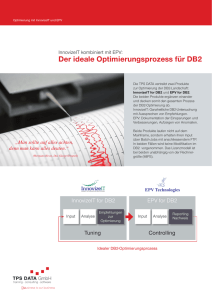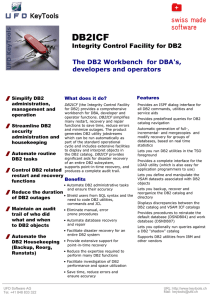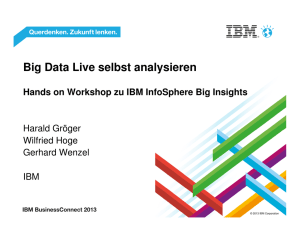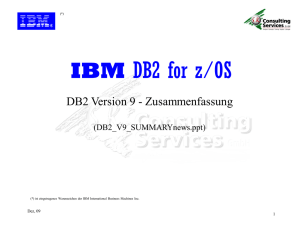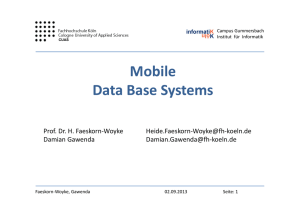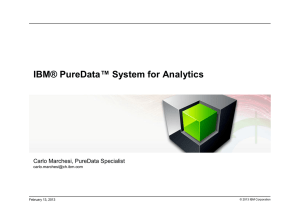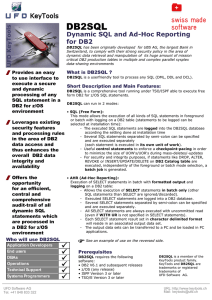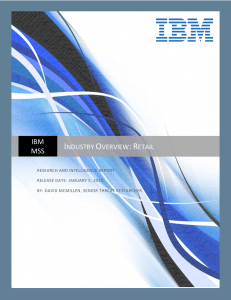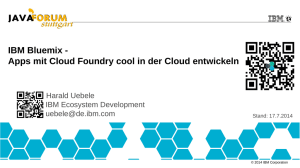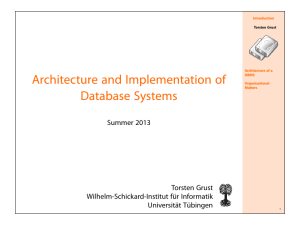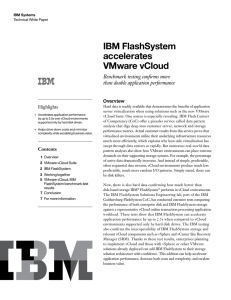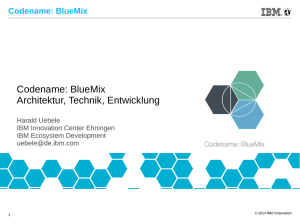Toolbox_Tips_IBM DB2
Werbung
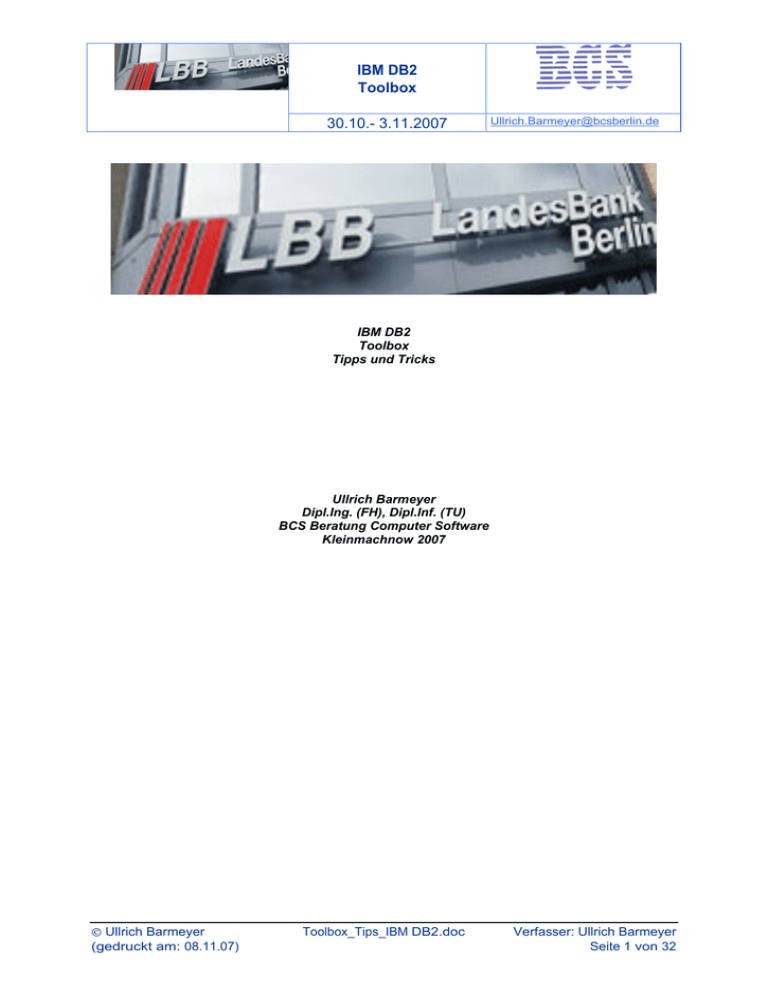
IBM DB2 Toolbox 30.10.- 3.11.2007 [email protected] IBM DB2 Toolbox Tipps und Tricks Ullrich Barmeyer Dipl.Ing. (FH), Dipl.Inf. (TU) BCS Beratung Computer Software Kleinmachnow 2007 Ullrich Barmeyer (gedruckt am: 08.11.07) Toolbox_Tips_IBM DB2.doc Verfasser: Ullrich Barmeyer Seite 1 von 32 IBM DB2 Toolbox 30.10.- 3.11.2007 1. [email protected] Systemtabellen 1.1. Abfrage der vorhandenen Datenbanktabellen Die System-Datenbanktabelle SYSTABLES enthält die Namen aller DB2 Tabellen in dieser Datenbank. Beispiel: select * from sysibm.systables -----------------------------------------------------------------------------Ergebnisse für eine einzelne Abfrage werden auf der Indexzunge 'Abfrageergebnisse' angezeigt. 100 Zeile(n) erfolgreich zurückgegeben Ullrich Barmeyer (gedruckt am: 08.11.07) Toolbox_Tips_IBM DB2.doc Verfasser: Ullrich Barmeyer Seite 2 von 32 IBM DB2 Toolbox 30.10.- 3.11.2007 1.2. [email protected] Ab fra g e d er Sp a ltenna m en (Colum ns) Die Tabelle SYSCOLUMNS enthält alle Spaltennamen aller Tabellen (gesammelt). select * from sysibm.syscolumns; Sehr gut geeignet auch für die Frage: Wo kommt überall die Spalte KUNDENR vor? Ullrich Barmeyer (gedruckt am: 08.11.07) Toolbox_Tips_IBM DB2.doc Verfasser: Ullrich Barmeyer Seite 3 von 32 IBM DB2 Toolbox 30.10.- 3.11.2007 1.3. [email protected] Suchen nach einer bestimmten Tabelle Durch verwendung des LIKE-Poperators lassen sich Tabellen mit ähnlichen Namen finden: select * from sysibm.systables where name like 'USER%' Ullrich Barmeyer (gedruckt am: 08.11.07) Toolbox_Tips_IBM DB2.doc Verfasser: Ullrich Barmeyer Seite 4 von 32 IBM DB2 Toolbox 30.10.- 3.11.2007 1.4. [email protected] Anzeige der Tabelle In obigem Ergebnis ist auch der Tabellen-CREATOR sichtbar. Dies entspricht dem Schema, mit dem die Abfrage direkt auf die gesuchte Tabelle durchgeführt werden muss: Hier ist CREATOR = SCHEMA = DB select * from db.user_registration Ullrich Barmeyer (gedruckt am: 08.11.07) Toolbox_Tips_IBM DB2.doc Verfasser: Ullrich Barmeyer Seite 5 von 32 IBM DB2 Toolbox 30.10.- 3.11.2007 2. [email protected] Liste d er DB2 Funktionen Ullrich Barmeyer (gedruckt am: 08.11.07) Toolbox_Tips_IBM DB2.doc Verfasser: Ullrich Barmeyer Seite 6 von 32 IBM DB2 Toolbox 30.10.- 3.11.2007 Ullrich Barmeyer (gedruckt am: 08.11.07) Toolbox_Tips_IBM DB2.doc [email protected] Verfasser: Ullrich Barmeyer Seite 7 von 32 IBM DB2 Toolbox 30.10.- 3.11.2007 Ullrich Barmeyer (gedruckt am: 08.11.07) Toolbox_Tips_IBM DB2.doc [email protected] Verfasser: Ullrich Barmeyer Seite 8 von 32 IBM DB2 Toolbox 30.10.- 3.11.2007 Ullrich Barmeyer (gedruckt am: 08.11.07) Toolbox_Tips_IBM DB2.doc [email protected] Verfasser: Ullrich Barmeyer Seite 9 von 32 IBM DB2 Toolbox 30.10.- 3.11.2007 Ullrich Barmeyer (gedruckt am: 08.11.07) Toolbox_Tips_IBM DB2.doc [email protected] Verfasser: Ullrich Barmeyer Seite 10 von 32 IBM DB2 Toolbox 30.10.- 3.11.2007 Ullrich Barmeyer (gedruckt am: 08.11.07) Toolbox_Tips_IBM DB2.doc [email protected] Verfasser: Ullrich Barmeyer Seite 11 von 32 IBM DB2 Toolbox 30.10.- 3.11.2007 Ullrich Barmeyer (gedruckt am: 08.11.07) Toolbox_Tips_IBM DB2.doc [email protected] Verfasser: Ullrich Barmeyer Seite 12 von 32 IBM DB2 Toolbox 30.10.- 3.11.2007 Ullrich Barmeyer (gedruckt am: 08.11.07) Toolbox_Tips_IBM DB2.doc [email protected] Verfasser: Ullrich Barmeyer Seite 13 von 32 IBM DB2 Toolbox 30.10.- 3.11.2007 Ullrich Barmeyer (gedruckt am: 08.11.07) Toolbox_Tips_IBM DB2.doc [email protected] Verfasser: Ullrich Barmeyer Seite 14 von 32 IBM DB2 Toolbox 30.10.- 3.11.2007 Ullrich Barmeyer (gedruckt am: 08.11.07) Toolbox_Tips_IBM DB2.doc [email protected] Verfasser: Ullrich Barmeyer Seite 15 von 32 IBM DB2 Toolbox 30.10.- 3.11.2007 Ullrich Barmeyer (gedruckt am: 08.11.07) Toolbox_Tips_IBM DB2.doc [email protected] Verfasser: Ullrich Barmeyer Seite 16 von 32 IBM DB2 Toolbox 30.10.- 3.11.2007 Ullrich Barmeyer (gedruckt am: 08.11.07) Toolbox_Tips_IBM DB2.doc [email protected] Verfasser: Ullrich Barmeyer Seite 17 von 32 IBM DB2 Toolbox 30.10.- 3.11.2007 Ullrich Barmeyer (gedruckt am: 08.11.07) Toolbox_Tips_IBM DB2.doc [email protected] Verfasser: Ullrich Barmeyer Seite 18 von 32 IBM DB2 Toolbox 30.10.- 3.11.2007 Ullrich Barmeyer (gedruckt am: 08.11.07) Toolbox_Tips_IBM DB2.doc [email protected] Verfasser: Ullrich Barmeyer Seite 19 von 32 IBM DB2 Toolbox 30.10.- 3.11.2007 Ullrich Barmeyer (gedruckt am: 08.11.07) Toolbox_Tips_IBM DB2.doc [email protected] Verfasser: Ullrich Barmeyer Seite 20 von 32 IBM DB2 Toolbox 30.10.- 3.11.2007 [email protected] BEISPIELE *************************************************************************** ** * * README for IBM COBOL Samples on Windows * * Last updated: October 2002 * * These programming examples are for the COBOL programming language, and can * be found in the "sqllib\samples\cobol" directory. Copy these files to your * working directory prior to building the sample programs. * * WARNING: Some of these samples may change your database or database manager * configuration. Execute the samples against a 'test' database only, * such as the DB2 SAMPLE database. * *************************************************************************** ** * QUICKSTART * * 1) Copy \sqllib\samples\cobol\* to a working directory * 2) Modify the makefile to reflect your environment: * o set DB (database name as cataloged: default is "sample") * o set UID (user ID to access the database) * o set PWD (password to access the database) * * 3) Excute 'nmake all' from the working directory * *************************************************************************** ** * For information on developing COBOL applications, see the * Application Development Guide. * * For information on DB2 APIs, see the Administrative API Reference. * * For information on using SQL statements, see the SQL Reference. * * For the latest information on programming, compiling, and running * DB2 applications, visit the DB2 application development website: * http://www.software.ibm.com/data/db2/udb/ad *************************************************************************** ** * * +--------------------------------------------+ +--+How to build the SAMPLE programs using nmake+----------------------------+ | +--------------------------------------------+ | | Note: The supplied makefile runs the IBM VisualAge COBOL compiler. | Ullrich Barmeyer (gedruckt am: 08.11.07) Toolbox_Tips_IBM DB2.doc Verfasser: Ullrich Barmeyer Seite 21 von 32 IBM DB2 Toolbox 30.10.- 3.11.2007 [email protected] | | | | | Before building the sample programs, you require: | | - The sample database (created with the db2sampl commmand). | | - The database manager must be started (with the db2start command). | | - Write permission to the the "sqllib\function" directory of | | the database instance prior to building the following programs: | | | | outsrv | | inpsrv | | | | Using the makefile in this directory, you can build any of the supplied | | sample programs in one step by entering the following command: | | | | nmake <prog_name> (eg. nmake updat) | | | | You can also use the makefile to build all the supplied sample programs | | in one step by entering the following command: | | | | nmake all | | | | To remove the intermediate files, enter: | | | | nmake clean | | | | To remove all intermediate and the resulting executables, enter: | | | | nmake cleanall | | | Ullrich Barmeyer (gedruckt am: 08.11.07) Toolbox_Tips_IBM DB2.doc Verfasser: Ullrich Barmeyer Seite 22 von 32 IBM DB2 Toolbox 30.10.- 3.11.2007 [email protected] | Although the makefile is easier to use, it may be more difficult to | | understand, so batch files are also included, as described below. | +----------------------------------------------------------------------------+ +----------------------------------------------------+ +--+ How to build the SAMPLE programs using batch files +--------------------+ | +----------------------------------------------------+ | | To compile the following programs, you need to invoke the proper build | | commands. The supplied batch files are listed near the end of the README. | +----------------------------------------------------------------------------+ Table Legend: ============= NOTES: CLI SRV STP A client You must A stored and must application, which calls a stored procedure. run this sample locally on the server. procedure, which must be stored on the server, be called by a corresponding client application. -------------+------+--------------------------------------------------SAMPLE |NOTES | PROGRAM DESCRIPTION PROGRAM | | NAME | | -------------+------+-------------------------------------------------advsql.sqb | |An example using advanced SQL expressions like | |CASE, CAST, and scalar fullselects. -------------+------+-------------------------------------------------checkerr.cbl| |Demonstrates the use of the following APIs: | | GET ERROR MESSAGE | | INSTALL SIGNAL HANDLER | | INTERRUPT | |This program also contains code to output | |information from an SQLDA. -------------+------+-------------------------------------------------client.cbl | |Demonstrates the use of the following APIs: | | SET CLIENT | | QUERY CLIENT -------------+------+-------------------------------------------------cursor.sqb | |Demonstrates the use of a "CURSOR" using static | |SQL. -------------+------+-------------------------------------------------d_dbconf.cbl| |Demonstrates the use of the following API: | | GET DATABASE CONFIGURATION DEFAULTS -------------+------+-------------------------------------------------d_dbmcon.cbl| |Demonstrates the use of the following API: | | GET DATABASE MANAGER CONFIGURATION DEFAULTS -------------+------+-------------------------------------------------db_udcs.cbl | |Demonstrates the use of the following APIs to | |simulate the collating behavior of a DB2 for Ullrich Barmeyer (gedruckt am: 08.11.07) Toolbox_Tips_IBM DB2.doc Verfasser: Ullrich Barmeyer Seite 23 von 32 IBM DB2 Toolbox 30.10.- 3.11.2007 [email protected] | |MVS/ESA CCSID 500 (EBCDIC International) | |collating sequence: | | CREATE DATABASE | | DROP DATABASE -------------+------+-------------------------------------------------dbauth.sqb | |Demonstrates the use of the GRANT | | (Database Authorities) SQL statement -------------+------+-------------------------------------------------dbcat.cbl | |Demonstrates the use of the following APIs: | | CATALOG DATABASE | | CLOSE DATABASE DIRECTORY SCAN | | GET NEXT DATABASE DIRECTORY ENTRY | | OPEN DATABASE DIRECTORY SCAN | | UNCATALOG DATABASE -------------+------+-------------------------------------------------dbcmt.cbl | |Demonstrates the use of the following API: | | CHANGE DATABASE COMMENT -------------+------+-------------------------------------------------dbconf.cbl | |Demonstrates the use of the following APIs: | | CREATE DATABASE | | DROP DATABASE | | GET DATABASE CONFIGURATION | | RESET DATABASE CONFIGURATION | | UPDATE DATABASE CONFIGURATION -------------+------+-------------------------------------------------dbinst.cbl | |Demonstrates the use of the following APIs: | | ATTACH TO INSTANCE | | DETACH FROM INSTANCE | | GET INSTANCE -------------+------+-------------------------------------------------dbmconf.cbl | |Demonstrates the use of the following APIs: | | GET DATABASE MANAGER CONFIGURATION | | RESET DATABASE MANAGER CONFIGURATION | | UPDATE DATABASE MANAGER CONFIGURATION -------------+------+-------------------------------------------------dbsnap.cbl | |Demonstrates the use of the following API: | | DATABASE MONITOR SNAPSHOT -------------+------+-------------------------------------------------dbstart.cbl | SRV |Demonstrates the use of the following API: | | START DATABASE MANAGER -------------+------+-------------------------------------------------dbstat.sqb | |Demonstrates the use of the following APIs: | | REORGANIZE TABLE | | RUN STATISTICS -------------+------+-------------------------------------------------dbstop.cbl | SRV |Demonstrates the use of the following APIs: | | FORCE USERS | | STOP DATABASE MANAGER -------------+------+-------------------------------------------------dcscat.cbl | |Demonstrates the use of the following APIs: | | ADD DCS DIRECTORY ENTRY | | CLOSE DCS DIRECTORY SCAN | | GET DCS DIRECTORY ENTRY FOR DATABASE | | GET DCS DIRECTORY ENTRIES | | OPEN DCS DIRECTORY SCAN | | UNCATALOG DCS DIRECTORY ENTRY -------------+------+-------------------------------------------------Ullrich Barmeyer (gedruckt am: 08.11.07) Toolbox_Tips_IBM DB2.doc Verfasser: Ullrich Barmeyer Seite 24 von 32 IBM DB2 Toolbox 30.10.- 3.11.2007 [email protected] delet.sqb | |Uses static SQL to delete items from a database. -------------+------+-------------------------------------------------dynamic.sqb | |Demonstrates the use of a "CURSOR" using dynamic | |SQL. -------------+------+-------------------------------------------------ebcdicdb.cbl| |Demonstrates the use of the following APIs to | |simulate the collating behavior of a DB2 for | |MVS/ESA CCSID 037 (EBCDIC US English) | |collating sequence: | | CREATE DATABASE | | DROP DATABASE -------------+------+--------------------------------------------------expsamp.sqb | |Demonstrates the use of the following APIs: | | EXPORT | | IMPORT | |in conjunction with a DRDA database. -------------+------+-------------------------------------------------impexp.sqb | |Demonstrates the use of the following APIs: | | EXPORT | | IMPORT -------------+------+-------------------------------------------------inpcli.sqb | CLI |Demonstrates how to call a parameter style GENERAL | |stored procedure. This is the client program of a | |client/server example. (The server program is | |called "inpsrv".) The SQLCA status is returned | |to the client program. This program uses an | |embedded SQL CALL statement to call the stored | |procedure. -------------+------+-------------------------------------------------inpsrv.sqb | STP |Demonstrates parameter style GENERAL stored | |procedures. This is the server program of a | |client/server example. (The client program is | |called "inpcli".) The procedure in this file | |inserts a row into the ORG table in the SAMPLE | |database. The server program does all the | |database processing and returns the SQLCA | |status to the client program. -------------+------+-------------------------------------------------joinsql.sqb | |An example using advanced SQL join expressions. -------------+------+-------------------------------------------------loadqry.sqb | |Demonstrates how APIs are implemented in order | |to query the current status of a LOAD being | |invoked on the table "TABLE" in the database | |"SAMPLE". -------------+------+-------------------------------------------------lobeval.sqb | |Demonstrates the use of deferring the evaluation | |of a LOB within a database. -------------+------+-------------------------------------------------lobfile.sqb | |Demonstrates the use of LOB file handles. -------------+------+-------------------------------------------------lobloc.sqb | |Demonstrates the use of LOB locators. -------------+------+-------------------------------------------------migrate.cbl | |Demonstrates the use of the following API: | | MIGRATE DATABASE -------------+------+-------------------------------------------------monreset.cbl| |Demonstrates the use of the follwing API: | | RESET DATABASE SYSTEM MONITOR DATA AREAS Ullrich Barmeyer (gedruckt am: 08.11.07) Toolbox_Tips_IBM DB2.doc Verfasser: Ullrich Barmeyer Seite 25 von 32 IBM DB2 Toolbox 30.10.- 3.11.2007 [email protected] -------------+------+-------------------------------------------------monsz.cbl | |Demonstrates the use of the following APIs: | | ESTIMATE DATABASE SYSTEM MONITOR BUFFER SIZE | | DATABASE SYSTEM MONITOR SNAPSHOT -------------+------+-------------------------------------------------nodecat.cbl | |Demonstrates the use of the following APIs: | | CATALOG NODE | | CLOSE NODE DIRECTORY SCAN | | GET NEXT NODE DIRECTORY ENTRY | | OPEN NODE DIRECTORY SCAN | | UNCATALOG NODE -------------+------+-------------------------------------------------openftch.sqb| |Uses static SQL to fetch rows and then UPDATE | |or DELETE them. -------------+------+-------------------------------------------------outcli.sqb | CLI |Demonstrates stored procedures using the SQLDA | |structure. This is the client program of a | |client/server example. (The server program is | |called outsrv.sqb) This program allocates and | |initializes a one variable SQLDA, and passes it | |to the server program for further processing. | |The filled SQLDA is returned to the client | |program along with the SQLCA status. This | |uses an embedded SQL CALL statement to call | |a stored procedure. -------------+------+-------------------------------------------------outsrv.sqb | STP |Demonstrates stored procedures using the SQLDA | |structure. This is the server program of a | |client/server example. (The client program is | |called outcli.sqb) The program fills the SQLDA | |with the median "SALARY" of the employees in the | |"STAFF" table of the "SAMPLE" database. The | |server program does all the database processing | |(finding the median). The server program returns | |the filled SQLDA and the SQLCA status to the | |client program. -------------+------+-------------------------------------------------prepbind.sqb| SRV |Demonstrates the use of the following APIs: | | BIND | | PRECOMPILE PROGRAM -------------+------+-------------------------------------------------qload.sqb | |Demonstrates the use of the LOAD QUERY API -------------+------+-------------------------------------------------rebind.sqb | |Demonstrates the use of the REBIND API -------------+------+-------------------------------------------------restart.cbl | SRV |Demonstrates the use of the following API: | | RESTART DATABASE MANAGER -------------+------+-------------------------------------------------setact.cbl | |Demonstrates the use of the following API: | | SET ACCOUNTING STRING -------------+------+-------------------------------------------------spcat | |Script to uncatalog/catalog stored procedures by | |calling spdrop.db2 and spcreate.db2. This script | |must be used for inpsrv, but is not required for outsrv. -------------+------+-------------------------------------------------spcreate.db2| |CLP script to catalog the stored procedure called by Ullrich Barmeyer (gedruckt am: 08.11.07) Toolbox_Tips_IBM DB2.doc Verfasser: Ullrich Barmeyer Seite 26 von 32 IBM DB2 Toolbox 30.10.- 3.11.2007 [email protected] | |inpcli. This is not required for outsrv. -------------+------+-------------------------------------------------spdrop.db2 | |CLP script to uncatalog the stored procedure called by | |inpcli. This is not required for outsrv. -------------+------+-------------------------------------------------static.sqb | |Uses static SQL to retrieve information. -------------+------+-------------------------------------------------sws.cbl | |Demonstrates the use of the following API: | | DATABASE MONITOR SWITCH -------------+------+-------------------------------------------------tabscont.sqb| |Demonstrates the use of the following APIs: | | TABLESPACE CONTAINER QUERY | | OPEN TABLESPACE CONTAINER QUERY | | FETCH TABLESPACE CONTAINER QUERY | | CLOSE TABLESPACE CONTAINER QUERY | | SET TABLESPACE CONTAINER QUERY -------------+------+-------------------------------------------------tabspace.sqb| |Demonstrates the use of the following APIs: | | TABLESPACE QUERY | | SINGLE TABLESPACE QUERY | | OPEN TABLESPACE QUERY | | FETCH TABLESPACE QUERY | | GET TABLESPACE STATISTICS | | CLOSE TABLESPACE QUERY -------------+------+-------------------------------------------------tabsql.sqb | |An example using advanced SQL table expressions. -------------+------+-------------------------------------------------tload.sqb | SRV |Demonstrates the use of the following APIs: | | EXPORT | | QUIESCE TABLESPACES FOR TABLE | | LOAD -------------+------+-------------------------------------------------trigsql.sqb | |An example using advanced SQL triggers and | |contraints. -------------+------+-------------------------------------------------tspace.sqb | |Demonstrates the use of the following APIs: | | COPY MEMORY | | FREE MEMORY | | TABLESPACE QUERY | | TABLESPACE CONTAINER QUERY | | SINGLE TABLESPACE QUERY | | OPEN TABLESPACE QUERY | | FETCH TABLESPACE QUERY | | CLOSE TABLESPACE QUERY | | OPEN TABLESPACE CONTAINER QUERY | | FETCH TABLESPACE CONTAINER QUERY | | CLOSE TABLESPACE CONTAINER QUERY | | SET TABLESPACE CONTAINERS | | GET TABLESPACE STATISTICS -------------+------+-------------------------------------------------updat.sqb | |Uses static SQL to update a database. -------------+------+-------------------------------------------------varinp.sqb | |An example of variable input to Embedded Dynamic | |SQL calls using parameter markers. -------------+------+-------------------------------------------------- Ullrich Barmeyer (gedruckt am: 08.11.07) Toolbox_Tips_IBM DB2.doc Verfasser: Ullrich Barmeyer Seite 27 von 32 IBM DB2 Toolbox 30.10.- 3.11.2007 [email protected] -------------+------+--------------------------------------------------BATCH |NOTES | DESCRIPTION FILE | | NAME | | -------------+------+-------------------------------------------------bldapp.bat | |Builds an IBM COBOL application program. -------------+------+--------------------------------------------------bldrtn.bat | |Builds an IBM COBOL routine (stored procedure) | |program. -------------+------+--------------------------------------------------embprep.bat | |Batch file to prep and bind a COBOL embedded SQL | |program. -------------+------+--------------------------------------------------- -------------+------+--------------------------------------------------OTHER |NOTES | DESCRIPTION -------------+------+-------------------------------------------------makefile | |Builds most of the supplied programming examples in | |the "sqllib\samples\cobol" subdirectory. -------------+------+--------------------------------------------------README | |Lists and describes at a high-level, all files in | |the "sqllib\samples\cobol" sub-directory (this file). -------------+------+--------------------------------------------------- Ullrich Barmeyer (gedruckt am: 08.11.07) Toolbox_Tips_IBM DB2.doc Verfasser: Ullrich Barmeyer Seite 28 von 32 IBM DB2 Toolbox 30.10.- 3.11.2007 [email protected] *********************************************************************** ** Licensed Materials - Property of IBM ** ** Governed under the terms of the International ** License Agreement for Non-Warranted Sample Code. ** ** (C) COPYRIGHT International Business Machines Corp. 1995 - 2002 ** All Rights Reserved. ** ** US Government Users Restricted Rights - Use, duplication or ** disclosure restricted by GSA ADP Schedule Contract with IBM Corp. *********************************************************************** ** ** SOURCE FILE NAME: updat.sqb ** ** SAMPLE: How to update, delete and insert table data ** ** This sample program demonstrates the use of static SQL. ** It will obtain all managers in the STAFF table of the ** SAMPLE database and change their job from 'Mgr' to ** 'Clerk', deletes all who are 'Sales', and inserts a new ** row. In all three SQL statements (UPDATE, DELETE, ** INSERT) a host variable is implemented. A ROLLBACK will ** be done so that the SAMPLE database remains unchange. ** ** SQL STATEMENTS USED: ** BEGIN DECLARE SECTION ** END DECLARE SECTION ** ROLLBACK ** CONNECT ** UPDATE ** DELETE ** INSERT ** ** OUTPUT FILE: updat.out (available in the online documentation) *********************************************************************** ** ** For more information on the sample programs, see the README file. ** ** For information on developing COBOL applications, see the ** Application Development Guide. ** ** For information on using SQL statements, see the SQL Reference. ** ** For the latest information on programming, compiling, and running ** DB2 applications, visit the DB2 application development website: ** http://www.software.ibm.com/data/db2/udb/ad *********************************************************************** Identification Division. Program-ID. "updat". Data Division. Working-Storage Section. Ullrich Barmeyer (gedruckt am: 08.11.07) Toolbox_Tips_IBM DB2.doc Verfasser: Ullrich Barmeyer Seite 29 von 32 IBM DB2 Toolbox 30.10.- 3.11.2007 [email protected] copy "sql.cbl". copy "sqlenv.cbl". copy "sqlca.cbl". 1 EXEC SQL BEGIN DECLARE SECTION END-EXEC. 01 statement pic x(80). 01 userid pic x(8). 01 passwd. 49 passwd-length pic s9(4) comp-5 value 0. 49 passwd-name pic x(18). 01 job-update pic x(5). EXEC SQL END DECLARE SECTION END-EXEC. * Local variables 77 errloc 77 error-rc 77 state-rc 2 pic x(80). pic s9(9) comp-5. pic s9(9) comp-5. * Variables for the GET ERROR MESSAGE API * Use application specific bound instead of BUFFER-SZ 77 buffer-size pic s9(4) comp-5 value 1024. 77 line-width pic s9(4) comp-5 value 80. 77 error-buffer pic x(1024). 77 state-buffer pic x(1024). Procedure Division. Main Section. display "Sample COBOL program: UPDAT". display "Enter your user id (default none): " with no advancing. accept userid. if userid = spaces EXEC SQL CONNECT TO sample END-EXEC else display "Enter your password : " with no advancing accept passwd-name. * Passwords in a CONNECT format * with the length of the inspect passwd-name before initial " statement must be entered in a VARCHAR input string. tallying passwd-length for characters ". EXEC SQL CONNECT TO sample USER :userid USING :passwd END-EXEC. move "CONNECT TO" to errloc. call "checkerr" using SQLCA errloc. move "Clerk" to job-update. EXEC SQL UPDATE staff SET job=:job-update WHERE job='Mgr' END-EXEC. move "UPDATE STAFF" to errloc. call "checkerr" using SQLCA errloc. Ullrich Barmeyer (gedruckt am: 08.11.07) Toolbox_Tips_IBM DB2.doc 3 4 Verfasser: Ullrich Barmeyer Seite 30 von 32 IBM DB2 Toolbox 30.10.- 3.11.2007 [email protected] display "All 'Mgr' have been demoted to 'Clerk'!". move EXEC move call "Sales" to job-update. SQL DELETE FROM staff WHERE job=:job-update END-EXEC. "DELETE FROM STAFF" to errloc. "checkerr" using SQLCA errloc. 5 display "All 'Sales' people have been deleted!". EXEC SQL INSERT INTO staff VALUES (999, 'Testing', 99, :job-update, 0, 0, 0) END-EXEC. move "INSERT INTO STAFF" to errloc. call "checkerr" using SQLCA errloc. 6 display "New data has been inserted". EXEC SQL ROLLBACK END-EXEC. move "ROLLBACK" to errloc. call "checkerr" using SQLCA errloc. 7 DISPLAY "On second thought -- changes rolled back." EXEC SQL CONNECT RESET END-EXEC. move "CONNECT RESET" to errloc. call "checkerr" using SQLCA errloc. End-Prog. stop run. Ullrich Barmeyer (gedruckt am: 08.11.07) Toolbox_Tips_IBM DB2.doc Verfasser: Ullrich Barmeyer Seite 31 von 32 IBM DB2 Toolbox 30.10.- 3.11.2007 [email protected] QUELLEN Kapitel 2 - DB2 Funktionen Ullrich Barmeyer (gedruckt am: 08.11.07) Toolbox_Tips_IBM DB2.doc Verfasser: Ullrich Barmeyer Seite 32 von 32 This document was created with Win2PDF available at http://www.win2pdf.com. The unregistered version of Win2PDF is for evaluation or non-commercial use only. This page will not be added after purchasing Win2PDF.
